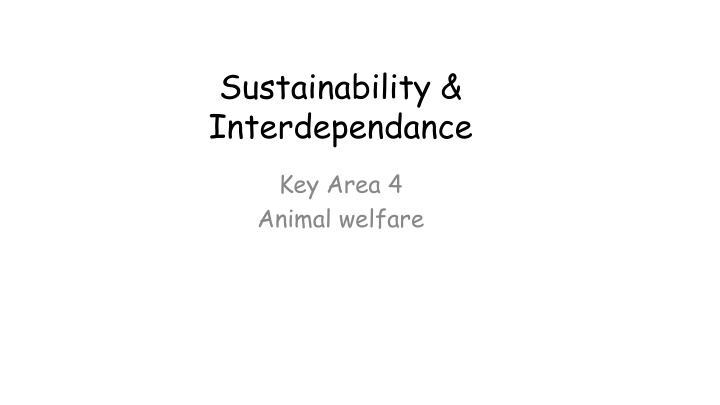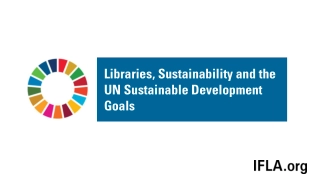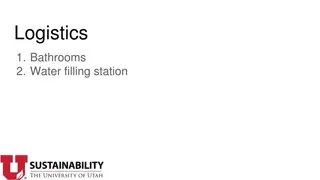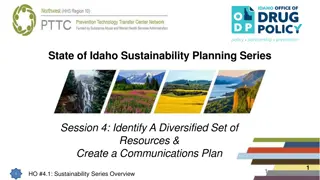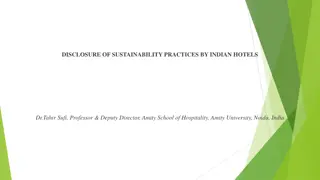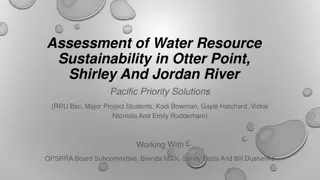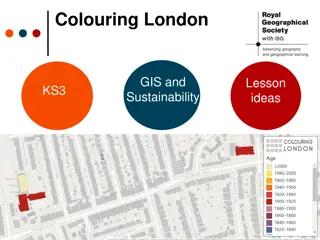Sustainability & Interdependance
Explore the dynamics of animal welfare in livestock production, including the costs, benefits, and ethical considerations of providing different levels of welfare. Learn about behavioral indicators, natural behaviors of domesticated animals, and the impact of environmental conditions on animal well-being.
Download Presentation

Please find below an Image/Link to download the presentation.
The content on the website is provided AS IS for your information and personal use only. It may not be sold, licensed, or shared on other websites without obtaining consent from the author.If you encounter any issues during the download, it is possible that the publisher has removed the file from their server.
You are allowed to download the files provided on this website for personal or commercial use, subject to the condition that they are used lawfully. All files are the property of their respective owners.
The content on the website is provided AS IS for your information and personal use only. It may not be sold, licensed, or shared on other websites without obtaining consent from the author.
E N D
Presentation Transcript
Sustainability & Interdependance Key Area 4 Animal welfare
Learning Intentions By the end of this topic you should be able to: Outline the costs, benefits and ethics of providing different levels of animal welfare in livestock production. State that behavioural indicators include stereotypy, misdirected behaviour, failure in sexual or parental behaviour, altered levels of activity. State that behaviours of domesticated animals can be observed in natural and semi-natural settings. State that information from studies of animal preferences can be used to improve environmental conditions for domesticated animals. State that the use of preference tests and measurements of motivation in animal welfare studies.
Animal welfare A domesticated animal s state of wellbeing was previously based on its physical health alone (ability to grow, reproduce, raise offspring successfully and resist disease). However, the Farm Animal Welfare Act now states it is acceptable only if the animal is able to behave in a natural way, free from disease and grow vigorously VS
Animal welfare For example, hens able to stretch their wings and wag their tails take less time to settle and begin egg-laying than those that are crowded and short of space VS
Animal welfare Intensive farming is less ethical than free range farming due to poorer animal welfare VS
Animal welfare Providing livestock with good environmental conditions to live in involves: Costs Benefits Ethics
Cost, Benefits and Ethics The initial increased cost associated with moving to free range includes providing animals with better conditions (more land) and it being more labour intensive. However, this usually leads to long term benefits Content, unstressed animals grow/breed better Farm products are of higher quality and so are sold for more money
Intensive farming benefits Intensive farming often creates conditions of poor animal welfare but it is often more cost effective as it generates higher profit as costs are low
Cost, Benefits and Ethics Ethics: moral values & rules that govern human conduct. In animal welfare this means making sure that animals don t suffer pain, distress or a low quality of life
Poor welfare: behavioural indicators Comparing the behaviour of an animal kept in unnatural or substandard conditions to those in a natural environment can help provide indicators of poor welfare. Examples of behavioural indicators include: Stereotypy Misdirected behaviour Failure in sexual or parental behaviour Altered levels of activity
Stereotypy Repetitive movements that lack variation usually due to cramped or bare quarters (eg. pigs continuous chewing movements when no food in mouth; cattle rolling their tongues; cats pacing back and forward) This is reduced when the environment is enriched(increased size for natural exercise or including features from the animal s natural habitat)
Misdirected behaviour Normal behaviour is directed inappropriately towards itself, another animals or its environment Animals may mutilate themselves by over-grooming, plucking or chewing themselves Birds may peck one another s skin (misdirected foraging) Sucking of inanimate objects or chewing bars (common in mammals separated from mothers early on)
Misdirected behaviour This can be avoided by enriching their environment by providing companions of their own type in larger areas with sounds and scents found in their natural environment
Failure of sexual/parental behaviour Poor conditions can be responsible for failure of animals to breed successfully. It can also lead to offspring being rejected. This is overcome by social contact with members of their own species in a spacious environment, particularly early on in development.
Altered levels of activity Very low (apathy) or very high (hysteria) levels of activity indicate poor animal welfare conditions
